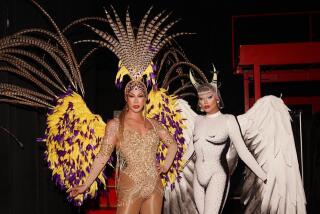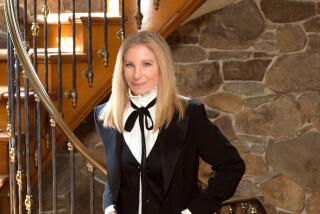She’s Leading by a Nose, Naturally : Characteristic: When the feature is featured, the center of the face is the center of attention. Especially in Barbra Streisand’s case.
Barbra Streisand has been a nose revolutionary, a nose nationalist and liberator, a preacher of proboscis pride, a nostro-terrorist, a prophet who saw the pert, snub, freckled, upturned, tidy, tiny, cute all-American cheerleader popularity of the ideal nose personified by Doris Day back in the 1950s, and she bloodied it.
“I kept my nose to spite my face,” she sings in “I’m Still Here,” with new lyrics by Stephen Sondheim.
No bobbing, no jobbing--at least in the sense of some suburban monument to rhinoplasty. More than 100,000 people a year get nose jobs, and there’s nothing mysterious about the rules they’re obeying: a bridge descending at a 38-degree angle from the face, down to a tip projecting at up to 110 degrees of snubness from the upper lip.
Not for Barbra.
“Are you checking to see if I had a nose job?” she was heard to say during her concert at USAir Arena in Landover, Md., to someone studying her through binoculars.
Such an odd organ. So utterly prominent, so easily hurt, so easily ridiculed. Failure and humiliation are summed up in the phrase “bloody nose.”
A big, interesting nose can suggest sex, arrogance and mystery, three things that make our puritan democracy nervous. In a nose that’s bony like a raptor’s beak, it implies passion, energy, aggressiveness and a predatory aloofness. The Doris Day nose implies enthusiasm rather than passion, pep rather than energy, passivity rather than aggression. A big nose is serious. A little nose is sincere. Big is powerful; little is popular. Big is unique; little is one of the crowd. Big is ethnic; little is not.
But Basil Rathbone wasn’t ethnic, and he had a nose that looked like a ritual knife from a Neanderthal excavation. Consider the rapacious aristocracy of the nose of Virginia Woolf, big, but so delicate you imagine from pictures that it must have moved a little with every breath. Would Charles de Gaulle have gone as far without a nose so huge and beaked that it took him so far into the ridiculous that he came out the other side and was the epitome of dignity?
In America, we said these were Saxon or Gallic noses, as if to explain them away. Lyndon Johnson was ethnic? If not, with that big, coarse cowboy nose, how was it he looked so much like Golda Meir?
It is undemocratic. If you have no nose, you’re part of a crowd. Most democratic of all, if you have no nose, how can you look down it at people?
Noses are sexy. This may account for America’s unease with them, and with Barbra Streisand’s sexiness.
H. George Brennan, president of the Academy Academy of Facial Plastic and Reconstructive Surgery in Newport Beach, says: “She’s a plastic surgeon’s dream. From a technical standpoint, surgeons drool when they look at her. It’s not just her nose; it’s her chin. She has a receding chin. It’s as much of what throws her face off as her nose.”
Where do these rules come from? Brennan says they’re innate. He cites studies of small children who show greater interest in attractive faces. He says that reactions to composites show uniform standards of beauty across culture. Though not changes in fashion. Michael Jackson, for instance, may be the last entertainer in America to buy himself a Doris Day nose.
“In the late 1960s, the cute, retrousse nose was in fashion,” Brennan says. “Today, it’s a high, elegant bridge.” Barbra has ignored all of these.
Some people might like looking at Streisand’s nose. “Some people like looking at Edsels too.”
Ah, no. The nose has a strange glory to it, like those portraits whose eyes follow you around the room.
Maybe we could have a Cyrano de Bergerac Memorial Nose Hall of Fame.
Candidates: Anjelica Huston; George C. Scott; the coarse, workingman’s nose of Gerard Depardieu; the thick, flat bulldog nose of Robert De Niro playing Jake La Motta in “Raging Bull,” Karl Malden’s potato-truncheon whose tip starts to divide. King Saud. Anthony Quinn’s Zorba-the-Nose. Jack Nicholson’s slit nose in “Chinatown,” Woody Allen kidnaping the president’s nose in “Sleeper,” W.C. Fields’ enshrapneled fungus of an alcoholic nose, the ski-jump noses of Richard Nixon and Bob Hope. And, of course, Doris Day. It only seems fair.
And Barbra.
Those long nostril wings coursing back like the wake along the sides of an old mahogany speedboat, the Brancusi cartilage, the indomitably streamlined quality of a Chrysler Airflow from the late 1930s. It’s a brave nose. Her whole face depends on it. With that nose, happiness becomes triumph; sadness is poignancy. The nose invokes the sine qua non of beauty: contradiction. It is exotic and banal, powerful and vulnerable, public and private.
Barbra’s sloping chin evokes a child, of course. Hence our sympathies. But the nose is utter adulthood. Another contradiction, a structural beauty spot, an oxymoron. The Colossus of Nose.


